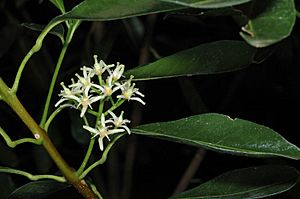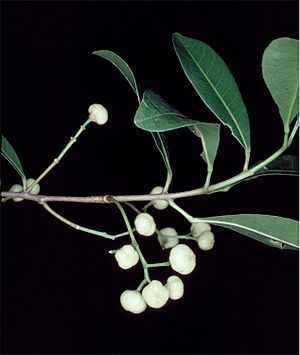White aspen facts for kids
Quick facts for kids White aspen |
|
|---|---|
 |
|
| Acronychia oblongifolia in the ANBG | |
| Scientific classification | |
| Genus: |
Acronychia
|
| Species: |
oblongifolia
|
| Synonyms | |
|
|
White aspen (also called yellow wood) is a type of shrub or medium-sized tree. It belongs to the citrus family, called Rutaceae. This plant grows naturally only in eastern Australia. It has simple, egg-shaped leaves. Its flowers are small and creamy-white. The tree also grows fleshy, round fruits that you can eat.
Contents
What Does White Aspen Look Like?
White aspen, known scientifically as Acronychia oblongifolia, can grow as a shrub or a tree. It can reach up to 27 meters (about 89 feet) tall. The trunk is usually dark brown and smooth. Sometimes it has small wrinkles or cracks.
Its leaves are mostly simple, meaning they are not divided into smaller leaflets. They grow in pairs opposite each other on the stem. The leaves are shaped like a spear or an egg, wider at the top and narrower at the base. They are about 3 to 12 centimeters (1.2 to 4.7 inches) long and 1.4 to 5 centimeters (0.5 to 2 inches) wide. Each leaf has a stalk called a petiole that is 0.5 to 3.2 centimeters (0.2 to 1.3 inches) long.
The leaves feel leathery and are dark green. They also have a nice smell. Sometimes, a leaf might have three parts, which is called being trifoliate.
The flowers are creamy-white and grow in small groups. These groups are usually found where a leaf meets the stem, called a leaf axil. Each flower is about 1 centimeter (0.4 inches) wide. It sits on a small stalk called a pedicel.
Each flower has four small leaf-like parts called sepals. It also has four petals, which are about 4.5 to 7 millimeters (0.18 to 0.28 inches) long. Inside the flower, there are eight stamens, which are the parts that produce pollen. These stamens are different lengths.
White aspen trees usually flower from February to June. After flowering, they produce fruit. The fruit is fleshy and can be white, yellow, or purplish. It is mostly round and about 0.5 to 0.9 centimeters (0.2 to 0.35 inches) long. These fruits are a type of drupe, which means they have a hard pit inside. The fruit ripens from May to December. Each fruit has four lobes and a small tuft of hairs at its end.
How White Aspen Got Its Name
The white aspen was first officially described in 1934. This description was made by a botanist named William Jackson Hooker. He used notes from another botanist, Allan Cunningham. Cunningham had originally given the plant the name Cyminosma oblongifolia.
Later, in 1840, a botanist named Stephan Endlicher suggested changing the name to Acronychia oblongifolia. This new name was then published by a German botanist, Gustav Heynhold. He included it in his book about plants introduced to European gardens.
The second part of the scientific name, oblongifolia, comes from Latin. "Folium" means "leaf". So, "oblongifolia" refers to the oblong (or egg-shaped) form of the leaves.
Where Does White Aspen Grow?
White aspen trees are found in eastern Australia. They grow from near Gympie in central-eastern Queensland. From there, they spread south through eastern New South Wales. You can also find a few groups of them in eastern Victoria.
This tree naturally lives in rainforests and along the edges of rainforests. Most white aspens are shrubs. However, in some places, they grow into full-sized trees. For example, they can be found as trees in the rainforests of the McPherson Range. This area is on the border between New South Wales and Queensland. They also grow as trees in the Mitchell River Gorge in Victoria.
Animals That Love White Aspen
The fruits of the white aspen are ripe between May and November. In Victoria, they can ripen until January. Many different birds enjoy eating these fruits.
Some of the birds that eat white aspen fruit include the green catbird, regent bowerbird, and satin bowerbird. Other birds like the pied currawong, topknot pigeon, and white-headed pigeon also feast on them. The blue-faced honeyeater and wompoo fruit dove are also known to eat these tasty fruits.
How People Use White Aspen
Growing White Aspen in Gardens
White aspen is a plant that people can grow in their gardens. It grows best in soil that drains water well. It also likes sunny spots. Giving the plant extra water and fertilizer can help it grow even better.
When the plant is young, it can be sensitive to frost. This means it needs protection from very cold temperatures. You can grow new white aspen plants from seeds or from cuttings (small pieces of the plant).
Eating White Aspen Fruit
The berries of the white aspen are said to have a flavor like lemon and orange. You can use them in different ways in food. They can be added to salads or served as a side dish. They also taste good when cooked with seafood or chicken.
People also use white aspen fruit to make preserves. They can be used in sauces, juices, and even cocktails.
See also
 In Spanish: Aspen blanco para niños
In Spanish: Aspen blanco para niños


